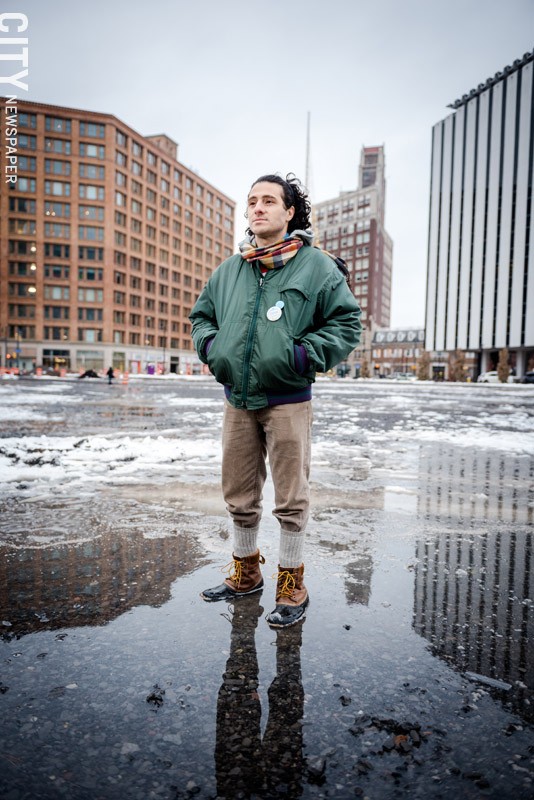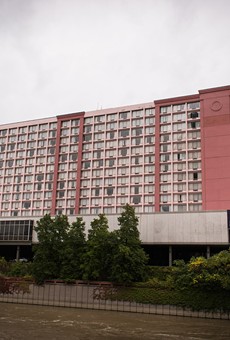Page 2 of 5
The public space activists
Two leaders in the movement to preserve Parcel 5 primarily as open space – at least for a few years – are artist Ray Ray Mitrano and social-media specialist Steve Carter.
Downtown, they say, should serve and attract people of all backgrounds, but much of the new development taking place is for wealthier people.
“Ideally,” says Carter, Parcel 5 should be “a space that’s a true public space, a true public square in a way.” That, he says, “is something that we’ve kind of lost here in the city. We don’t have a true central gathering point.”

- PHOTO BY JOSH SAUNDERS
- Steve Carter is a social media specialist at Eastman Kodak who has been involved in social media campaigns about Parcel 5. He’s a Roberts Wesleyan College grad who also started the Explore Rochester account on Instagram.
Even as a gravel-filled expanse, Parcel 5 is already democratizing downtown, says Carter. Right now, downtown lacks an inclusive, welcoming element. If Parcel 5 is developed as a public square or commons, it could fill that void.
“This is a commons,” says Mitrano. “This is something like the Boston Commons.”
Mitrano says he and other activists have been trying to “steer the energy” of people who don’t want what he calls “this big entertainment complex with residential-retail-luxury” and direct it toward a mixed-use public space, with events programmed for diverse audiences. That kind of use, Mitrano says, would be “more inclusive, more sustainable,” and would provide better social and economic benefits. They also think it would provide more jobs and more private investment, Mitrano says.
There’s little argument that Parcel 5 is a unique development site. It’s big, and it’s in a prominent position in the heart of downtown Rochester. But Carter, Mitrano, and other activists also point out that it gives the city a rare opportunity.
“You don’t get a prime piece of real estate like this often that the city gets to control,” says Carter.
And that provides a chance to “take some time and think about what can be added to the center of our downtown that can help shape the future of the city,” Carter says.
The heart of downtown, Carter says, should be where different people from many different backgrounds come together, and the RBTL theater and its adjacent apartment complex “gears the space toward wealthier, whiter demographics.”
“When we say we want a diverse and inclusive downtown for everyone, to rush to build things that force other people out is worrisome,” Carter says.
Carter says he and Parcel 5 activists have studied what other cities have done with similar parcels, including Columbus, Ohio; Cincinnati, Ohio; Chattanooga, Tennessee; Greenville, South Carolina; and Durham, North Carolina.
And Carter points to New York City’s Bryant Park. “It’s just grass with moveable chairs and tables,” he says, “but it’s very popular.”
Cleveland’s new Public Square, a 9 1/2-acre center-city park hosts year-round events, includes a water fountain feature (and wading is encouraged) and, in the winter, an ice rink.
Columbus, Ohio, has replaced a former 1950’s mall downtown with the 6-acre Columbus Commons, which hosts year-round events for children, food vendors, community group performances, and yoga on its bandshell stage.

- PHOTO BY JOSH SAUNDERS
- Ray Ray Mitrano is a multi-discipline artist who uses social engagement as one of those artistic disciplines. He’s a Visual Studies Workshop graduate who’s currently leading the Parcel 5 Community Programmers series, a collective effort to fund a series of monthly events at the site by collecting $5 donations from community members.
Mitrano envisions Parcel 5 as a place where people with ideas can experiment – entrepreneurs who may not be able to afford their own brick and mortar space. All it would take is some sort of “lightweight architecture” similar to the skate rental counter at the Dr. Martin Luther King, Jr. Memorial Park ice rink, “something that could be outfitted for food and whatnot,” Mitrano says.
If their ideas fail, says Mitrano, “it’s just an empty space again.”
A commons at Parcel 5 would also provide a place where organizations like the Taproot Collective and the Urban Agriculture Working Group could collaborate on urban farming and community gardening workshops, or Geva Theater and the Multi-use Community Cultural Center [MuCC] could collaborate “on things they would never be able to do inside their venues,” Mitrano says.
And Parcel 5’s best uses could emerge over time, with incremental steps to support them, Mitrano suggests. The city could begin the process by simply planting grass the first year and letting people walk on it, have picnics on it, or perform. The second year, walkways based on the paths people take through the site could be added, and so could trees, he says.
If demand for performances grew, in the second or third year money could be raised for a bandshell stage, Mitrano says. And with a stage could come other opportunities: the Little and Dryden theaters could partner on movie screenings. Community groups could organize medium- or large-scale festivals.
One concern raised by Mitrano, Carter, and many others is their sense that an RBTL theater would be dark for 160-plus days a year.
Should Rochester dedicate a key Main Street site to a large building that would be closed that much of the year? “That’s not a real good way to activate your dense urban core,” Carter says. “Right now, Midtown is becoming a place where there is activity. There’s a lot of activity. More businesses are moving in there, more housing is popping up in there. That’s what you want, and I think, with that, that draws more amenities – more restaurants and whatnot.”
Carter also refers to the theater concept as an attempt at “manufactured vibrancy,” and he has the same concern about the city’s ROC the Riverway plans for its riverside Charles Carroll Park. City officials hope to renovate Charles Carroll and Martin Luther King Jr. Park and boost their use.
That idea, says Carter, is City Hall declaring: “This is where you’re going to have all these events. This is where you’re going to gather. You gather here on the river. We’re going to put you here.”
But people aren’t gathering there right now, Carter says. They are, however, using Parcel 5 all the time: they’re walking through it, playing Wiffle Ball on it, and having pop-up concerts or other events there, he says.
“Yes, I think we should make the river something that draws people,” says Carter, “but they’re not naturally drawn to that place to spend a lot of time there.”
On Parcel 5, on the other hand, Jazz Festival and Fringe Festival events have drawn enormous crowds. The Roc the Taste food and music festival will be held there July 27-29. And Mitrano has been programming monthly events on the site.
And Carter thinks more groups would use the site if they knew how to get permission from the city. (The website for Cleveland’s Public Square contains an application form for people and groups who want to hold events on the site.)
Martin Luther King Jr. Park, Charles Carroll Park, and Washington Square Park are not ideal public spaces, says Mitrano. People don’t organically use them, he says. They’re pinned in by buildings and, in the case of Washington Square, a roadway with heavy traffic. Parcel 5, by contrast, has a steady flow of people crossing it, a fact that becomes obvious during the winter as people walk across the lot and beat tracks into the snow.
Carter thinks there are better places for RBTL’s theater and similar uses: sites on the rim of downtown, rather than at its core.
“It’s something that’s not used 24 hours a day,” Carter says, “so why does it need to be in a very dense area that needs multi-uses and activity most of the day?”
RBTL’s current location, in the Auditorium Theatre a few blocks east of the central business district, is that kind of site. Carter and other critics worry about what will happen to the Auditorium Theatre, an architecturally and historically valuable building, if RBTL moves its Broadway shows to a new theater.
And that’s a historic theater that would not be used if they got a new space, Carter says. “That’s a worry on our part,” he says, “and that would take something away from that area of the city.”
Carter adds: “It’s not that I don’t like the idea of a theater, a new theater – like a performing arts center. I think if there were to be something like that, it needs be more than one facet. This one is very much just able to do RBTL and things that RBTL programs, and couldn’t accommodate smaller places.”
The theater proposed for Parcel 5, Carter says, “wouldn’t ever be a true performing arts center.”
And, Carter asks: Who are we building the new theater for? RBTL’s core audience is older white women.
“That’s building for older generations instead of the future,” says Carter. While younger people may go to specific shows occasionally, “I don’t see that being a place that actively draws and attracts the next generation.”
Carter and Mitrano urge city officials to slow down. Do something temporarily, make it easier for more people to use Parcel 5, and test the possibilities. Get the community behind it.
And over time if it’s clear that there’s too much public space at Parcel 5, “maybe you can still put a building on the front end of it on Main Street and leave the back part empty,” Carter says.
If we build a theater and it’s not as successful as RBTL predicts, taxpayers would surely be called on to prop it up, Carter argues, because it’d be “one of those things that are too big to let fail.” That’s happened over and over with local projects including the soccer stadium, Frontier Field, and Blue Cross Arena, he says.
“Let the city, the downtown area around it grow up a little,” Carter says. “And then you find out what that area needs. Because right now they’re trying to force something in there that’s like ‘We need this, this will change everything,’ when, in fact, do we actually know that?”

